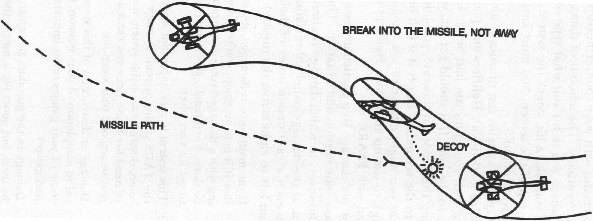Gunship Academy
by Richard Sheffield
Passive Countermeasures
Utilize N.O.E. terrain flight. Flying nap-of-the-earth is your best countermeasure against most AA weapons. Army Field Manual 90-1 defines terrain flight "the tactic of employing aircraft in such a manner as to utilize the terrain, vegetation, and manmade objects to enhance survivability by degrading the enemy's ability to visually, optically, or electronically detect or locate the aircraft. . . . Terrain flying, of necessity, involves flying close to the earth's surface."
Many of the enemy's weapons, although IR guided, require a visual sighting before launch. Flying low and staying behind hills will prevent the enemy from being able to acquire you visually and will stop the use of a number of weapons.
Employ standoff. The further away you are from the enemy position when you make an attack, the better the chance you have of destroying it before the enemy can launch. If they do launch before they're destroyed, being a good distance away will give you time to react and break contact with the enemy missile. Using NOE flight to get to a target area and then gaining some altitude to employ maximum standoff is a good combination of passive countermeasures.
Watch your threat indicator. Most enemy systems will show up on the Threat Indicator. Knowing that they're there and where they are will allow you to make good decisions as to whether to attack or evade. Enemy systems that appear on your flank can often be avoided by flying low and away from them. This is a good tactic to employ when on your way to a target area. By turning and attacking the weapon on your flank, you not only use time and fuel, but you might get drawn into a heavily defended area where you would receive a lot of damage before you could get out.
Minimize exposure time. It takes time for the enemy to set up and get off a shot at you. By limiting this time as much as possible, you'll decrease your chances of getting hit. You can limit your exposure time by doing the following:
Flying fast. High speed gets you in and out of range quickly, which is good. High speed also can get you into range of a large number of weapons faster than you can destroy them, which is bad. Bursts of speed are good for getting out of view quickly but should not be used for extended periods when over unknown territory.
Flying low. Enemy radar has very limited range at low altitude. The lower you are, the quicker you'll get out of range.
Using pop-up attacks. Popping up from behind a hill just long enough to attack a target and then dropping back down out of sight will limit the time the enemy has to acquire you and react.
Use your ECM properly. Electronic Countermeasures are great when used correctly but can be fatal if used when not needed. The time to use your radar and IR jammers is once you have been located by the enemy. These systems put out a very strong signal which is used to overpower the enemy system. They can be detected over a very long range, giving the enemy time to prepare for your attack. Limited use at night is especially important since the enemy will have a hard time acquiring you visually. You don't want to eliminate this advantage by flying around with your jammers on.
Use your decoys properly. Flares and chaff can save your life when a system cannot be jammed, but only if you maneuver correctly. When a missile is approaching you and you drop a flare or chaff, you must maneuver and change direction. Most missiles, once they lose their lock on you (even if jammed) will continue on straight ahead. If they were headed for you before they lost lock-on and you keep on the same flight path, you stand a good chance of getting hit anyway.
Keep moving in exposed areas. Once into a hot area, you are going to draw fire from a number of sources. Be careful not to pay so much attention to one target that you set yourself up for another. Don't hover unless you're protected by a hill and then keep a watch on your altitude. If you keep moving and feel that things are getting out of hand, you'll have enough speed to get out of the area in a hurry at low altitude.

Table of Contents
Previous Section: Active Countermeasures
Next Section: Damage!
